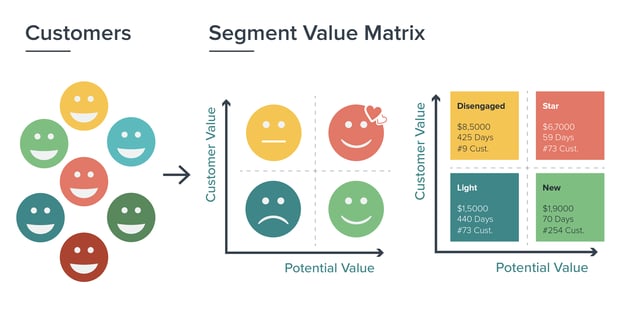Your technology may just be the solution that moves the planet towards a zero-emissions future. It’s a solid idea, the concept is proven and you’ve deployed units into the hands of selected clients, but getting “at-scale” adoption is proving to be a challenge.
It’s a unique problem: trying to sell a product (or service) that often has a long sales cycle and is relatively unknown in the marketplace - due in large part to its innovative nature. The complexity of the situation is compounded by not having clarity on high-potential markets and customers.
Marketing these technologies, from fuel cells to solar and wind energy production, to refurbished batteries for backup power is a challenge. As an agency specializing in B2B clean tech marketing, we have compiled some tips to help you get started.
How Clean Tech Companies Fail at Marketing
Technology companies often fail because they lack a focused approach in choosing a market segment to target. They see the potential for their product to solve problems in many markets, but the approach of tackling multiple markets at once leads to companies running out of money before their product is deployed at scale. Poor marketing, specifically poor segmenting and targeting is often the problem. Concentrating efforts can help a company win and dominate quickly, consequently reducing go-to-market risk.
How does marketing play a part in this? Oftentimes people think marketing is solely the promotion of the product through social media, events, advertising, email marketing, or on your website. These tactics, collectively known as marketing communications, need strategy and structure to be successful.
Before any tactics are deployed, you need to identify the right market, the right segment, while understanding your price, positioning and value proposition. Before any communications go out, you need to have a crystal clear understanding of who your audience is (through segmentation), what their pain points are (through building personas) and what your company is offering to solve these problems (what your value proposition is).
Maximizing the Impact of Clean Tech Marketing with Segmentation
Understand your product's entire potential addressable markets:
Your clean tech solution can solve many people's problems and can be used in numerous applications. Understand the market size of your product to get a sense of your company’s growth potential. Just like estimating your TAM (without exaggerating or underestimating this value), challenge your team to think about and define as many broad applications and uses for the product as possible. Encourage people to think in terms of how people, rather than companies, could use the product.
Group the potential markets into market segments.
How do you segment? There are numerous ways to group these segments and then many ways to determine which segments you should focus time and energy on right now. Let’s take all the potential markets, and segment them into specific verticals and categories within. For instance, Ballard Power Systems (a fuel cell company) works in a variety of markets, including public transit, heavy-duty mobility, marine, and critical infrastructure backup power. Since their work is diverse, their marketing efforts benefit from market segmentation. They are also able to focus their efforts by prioritizing as well as building a distinct strategy for each segment.
To accomplish this, ask yourself these questions:
- What are some common needs of these people/companies common needs, jobs-to-get-done, common behaviors, or other attributes?
- What’s "industry type" or "vertical”?
- What is the segment type?
- What’s the current value of the segment vs. the potential value?
- What’s the competition and what are they doing in these segments?
- How would these segments react to price changes - up and down?
We recommend testing your “thinking” and assumptions with market research. The more you know, the more targeted your program, and the more successful it will be.
Image via Marketing Insider Group
Choose a segment as the go-to-market target:
Having divided the market into segments and carefully choosing which market to move forward with will help:
- Improve marketing efforts by focusing on different segments
- Adapt products to specific segments
- Product pricing should differ depending on the segment and be appropriate
- Your organization should train its employees to serve customers better by understanding their needs
- Develop long-term relationships with high-potential customers.
Building Personas For Improved Marketing Outcomes
Once you’ve categorized your existing and potential customers, done your research and have chosen a segment to move forward with, you can now begin to create customer personas to represent that segment.
The old way (wrong way) of building personas is to use stereotypes and focus on demographic details. This leads to a surface-level understanding of behaviors that leads to biased stereotypes based on gender, ethnicity, age, and economic status.
To create personas the right way, you need to learn the pain points and challenges of your high-potential prospects and customers. Digging deeper reveals reasons why people will want to buy your product or service, other than the outright “benefit.” Go beyond demographics and think about situational information such as needs and requirements for their job or project, psychographic information such as goals, habits, values and interest, and behavioral information such as brand loyalty, media use, frequency of use, etc.
Personas can be as simple or as complex as you want them to be. What’s important is that you build them using real customer data gathered over time, combined with interviews with current or prospective customers. It’s always a good practice to speak with your clients to gather market intelligence. They know a lot more about your product (and the competitors) than you think.
Crafting An Irresistible Value Proposition
It might seem obvious how your product would help them or alleviate their problems but learning the ins and outs of what they experience on a daily basis will aid in fine-tuning your value proposition.
Remember:
- Start with your customers and not your product/service
- Map how your products/services create value
- Tweak or craft your value proposition
- Test it!

When creating a new piece of content, updating your product’s or service’s features, or developing a campaign - we implore you to develop marketing messages that strike a chord with a specific audience’s pain points.
Conclusion
Part of the challenge for clean tech businesses is getting the right message across to customers. In conclusion, segmenting your market, knowing your buyer and being able to serve their needs and tackle their problems will ultimately lead you to provide them with the best value possible. So, do this work first before sending out that press release, posting that on your website, or distributing a presentation deck.
Use the information in this guide as a foundation for what you can do to improve your message delivery and engagement with customers.

Sangeet Anand
Director of Digital Marketing Sangeet draws on her business background, creativity and technical know-how to deliver innovative marketing solutions for a variety of our clients.




